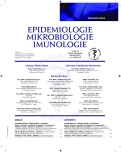Q fever – an occupational disease leading to disability – case report
Authors:
M. Nakládalová 1; R. Pastorková 2; I. Landecká 3
Authors place of work:
Klinika pracovního lékařství, Lékařská fakulta UP v Olomouci
1; Ústav sociálního lékařství a zdravotní politiky, Lékařská fakulta UP v Olomouci
2; Oddělení pracovního lékařství a nemocí z povolání, Karvinská hornická nemocnice, a. s.
3
Published in the journal:
Epidemiol. Mikrobiol. Imunol. 63, 2014, č. 2, s. 149-152
Category:
Souhrnná sdělení, původní práce, kazuistiky
Summary
Q fever is a zoonosis caused by the bacterium Coxiella burnetii. The infection results from inhalation of infected droplets or aerosols. The most frequent sources in the Czech Republic are sheep, horses, cattles, goats, and pigs. Frequently, the disease is deemed occupational, with male sex being a risk factor for its symptomatic form.
Presented is a case of a 27-year-old male diagnosed with a chronic form of Q fever after six months of worsening symptoms. Even years later, his condition is manifested as osteoarthritis, granulomatous hepatitis, and microcytic hypochromic anemia.
The source of infection was probably animal food stored in a facility where the patient was employed. He was recognized as having an occupational disease and being disabled, especially due to his severely impaired mobility.
Keywords:
Q fever – Coxiella burnetii – osteoarthritis – occupational disease – disability
Zdroje
1. Stein A, Raoult D. Pigeon pneumonia in Provence: A bird-borne Q fever outbreak. Clinical Infectious Disease, 1999;29,3:617–620.
2. Maurin M, Raoult D. Q fever. Clinical Microbiology Reviews, 1999;12, 4:518–553.
3. Euzéby J. P. List of bacterial names with standing in nomenclature: a Folder Available on the Internet. International Journal of Systematic Bacteriology, 1997;47,2:590–592. List of prokaryotic names with standing in nomenclature [online]. c1997-2013 [cit. 2013-10-07]. Dostupné na www: http://www.bacterio.net/coxiella.html >.
4. Parker NR, Barralet JH, Bell AM. Q fever. Lancet, 2006, vol. 367, p. 679–688.
5. Raoult D, Marrie T, Mege J. Natural history and pathophysiology of Q fever. Lancet Infectious Disease, 2005;5,4:219–226.
6. Gami AS, Antonios VS, Thompson RL, et al. Qfever endocarditis in the United States. Mayo Clinic Proceedings, 2004;79,2:253–257.
7. McQuiston JH, Holman RC, McCall CL, Childs JE, et al. National surveillance and the epidemiology of human Q fever in the United States, 1978–2004. American Journal of Tropical Medicine and Hygiene, 2006;75,1:36–40.
8. Dorko E, Čisláková L, Kizek P. Q horúčka – klinický obraz. Praktický lékař, 2005;85,7:382-384.
9. Votava, M. Q-horečka: vlastnosti původce. Praktický lékař, 2005;85,7:385–387.
10. Madariaga MG, Rezai K, Trenholme GM, Weinstein RA. Q fever: a biological weaponin your backyard. Lancet Infectious Diseases, 2003;3,3:709–721.
11. Kermode M, Yong K, Hurley S, Marmion B. An economic evaluation of increased uptake in Q fever vaccination among meat and agricultural industry workers following implementation of the National Q Fever Management Program. Australian and New Zealand Journal of Public Health, 2003;27,4:390–398.
12. Comer JA, Paddock CD, Childs JE. Urban zoonoses caused by Bartonella, Coxiella, Ehrlichia, and Rickettsia species. Vector Borne Zoonotic Disease, 2001;1,2:91–118.
13. Landais C, Fenollar F, Constantin A, et al. Q fever osteoarticular infection: four new cases and a review of the literature. European Journal of Clinical Microbiology and Infectious Diseases, 2007;26,5:341–347.
14. Karakousis PC, Trucksis M, Dumler JS. Chronic Q Fever in the United States. Journal of Clinical Microbiology, 2006;44,6:2283–2287. Dostupný na www: <http://www.ncbi.nlm.nih.gov/pmc/articles/PMC1489455/>.
15. Reid A, Malone J. Q fever in Ireland. A seroprevalence study of exposure to Coxiella bumettii among Department of Agriculture workers. Occupational Medicine, 2004;54,8:544–547.
Štítky
Hygiena a epidemiológia Infekčné lekárstvo MikrobiológiaČlánok vyšiel v časopise
Epidemiologie, mikrobiologie, imunologie

2014 Číslo 2
- Parazitičtí červi v terapii Crohnovy choroby a dalších zánětlivých autoimunitních onemocnění
- Očkování proti virové hemoragické horečce Ebola experimentální vakcínou rVSVDG-ZEBOV-GP
- Koronavirus hýbe světem: Víte jak se chránit a jak postupovat v případě podezření?
Najčítanejšie v tomto čísle
- Bodové prevalenčné sledovanie nozokomiálnych nákaz na Slovensku – súčasť projektu Európskej únie
- Výskyt Candida dubliniensis v klinickém materiálu a možnosti její identifikace
- Q-horečka jako profesionální onemocnění vedoucí k invaliditě – kazuistika
- Diagnostika Clostridium difficile infekcí – porovnávací studie dvou imunoenzymatických metod s konfirmací pomocí PCR a kultivace s následnou ribotypizací kmene*
